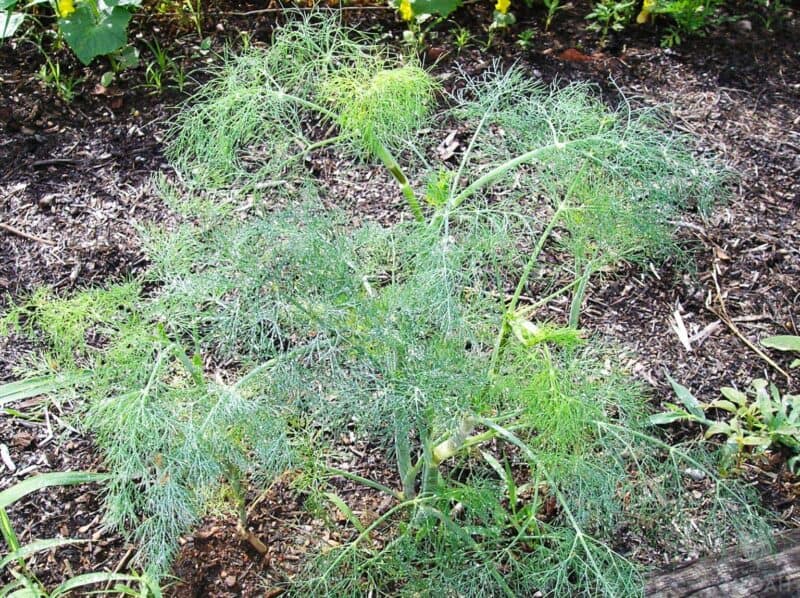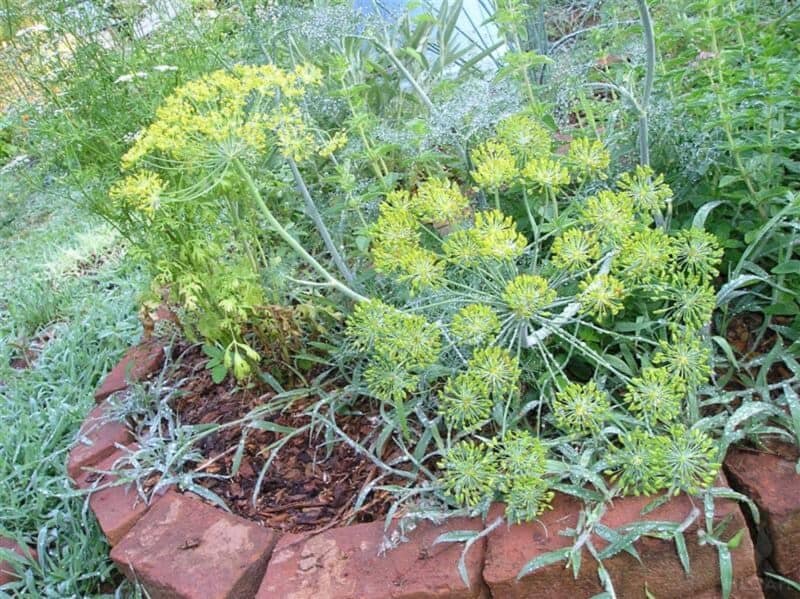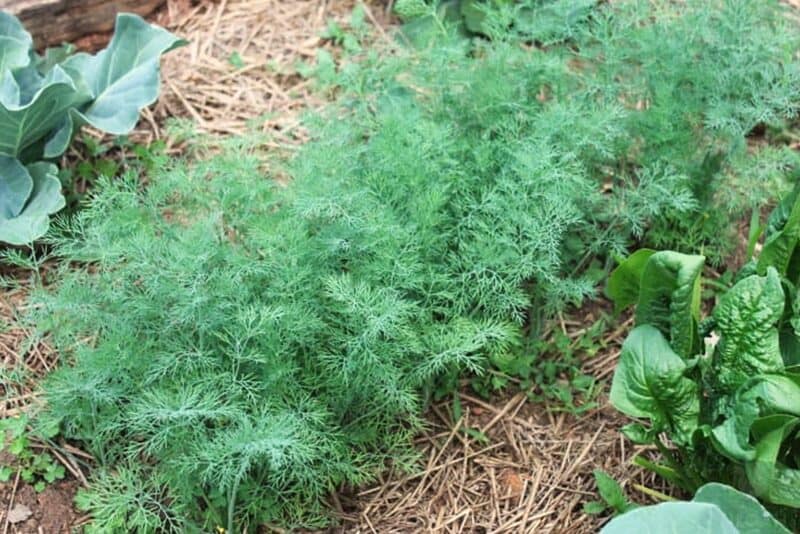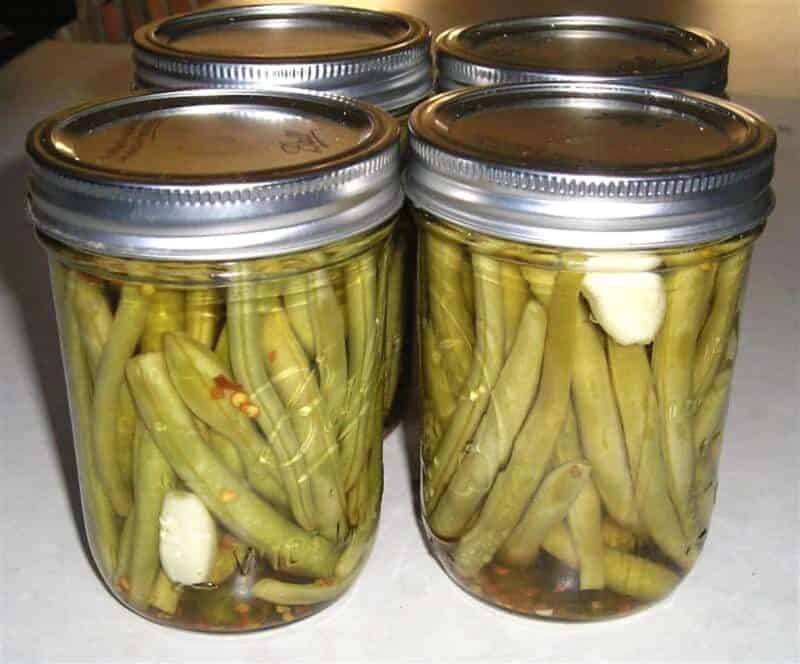Here’s a quick tip for ya. If you’re planning on doing any pickling, consider growing dill. Many pickling recipes call for a ‘head of dill’, which is basically the flower/seed head of the plant.
It’s nearly impossible to find fresh dill for sale in most grocery stores, and even many farmer’s markets won’t have any in stock. If you live in a rural area you might get lucky, but why go through the trouble of searching when dill is so easy to grow from seed?

The next time you plan on growing cucumbers in your garden (or anything you want to pickle, for that matter), set aside a little space for some dill plants.
Table of Contents:
What Exactly Is Dill?
Dill is a self-seeding plant with light, feathery green leaves. This plant is often used as an herb in stews, soups, and fish recipes, but it’s also a crucial ingredient for home pickling!
Dill is an annual, so you’ll want to replant every year. Besides being great for pickling, you can also use the leaves and dried seeds of dill for seasonings, and in recipes such as lemon-dill buttered baby carrots.
Dill is incredibly easy to grow, and it attracts a number of beneficial insects to your garden. Therefore it’s a great companion plant for numerous other species. A member of the Umbelliferae family, dill is actually closely related to carrots and other similar root crops.
This herb normally grows about two to four feet tall. It will produce fine, feathery bluish green leaves on hollow stems.
Later, it will produce yellowish-green flowers on flat-topped clusters, generally from midsummer until autumn. At the end of the growing season, it will produce light-brown seeds.
Dill Quick Facts
| Latin name | Anethum graveolens |
| growing zones | 3 – 11 |
| soil pH | 5.5 – 6.7 |
| type | biennial |
| height | 2 – 4 inches (5 to 10 cm) tall |
| seed depth | ¼ inch (5 mm) |
| seed spacing | 18″ (45 cm) |
| lighting needs | full sun |
| companions | corn, cabbage, onion, cucumber, lettuce, etc. |
Why Growing Your Own Dill is Better
Because growing your own vegetables and herbs is always better, of course!
But besides that, there are a number of reasons why you should be growing dill in your backyard herb or vegetable garden. Not only is dill exceptionally easy to grow, but it can really boost the health of your garden, too.
Plus, dill has been used for culinary and medicinal purposes for hundreds of years – its got quite the reputation behind it. You can use both the seeds and leaves of the plant, both of which give your food a strong, appetizing flavor.
It has numerous benefits, too. Here are just a few:
- It may help promote digestion.
- It prevents insomnia, as it is rich in vitamin B.
- It contains calcium and can improve and maintain your bone health.
- It can boost your immunity with its antimicrobial activity
- It can calm hiccups.
- It is a natural disinfectant that can prevent fungal infections.
- It is anti-inflammatory, meaning it will reduce inflammation and your overall risk of diseases like gout and arthritis.
- It is a natural antihistamine and can help treat allergies and coughs.
And the most important reason to grow your own dill? You’ll need it for all the dill pickles you’re going to make this year – right? You only need about one to two plants per household, as you can harvest it continuously.

Best Varieties of Dill
There aren’t a lot of varieties of dill to choose from, which will make your job somewhat easier when you head to the nursery. That being said, there are some minor differences between the varieties that you should know about.
- Bouquet dill: This is the most popular kind of dill, grown for its fragrant seeds and leaves. You can use both in pickling as well as in cooking.
- Fernleaf: Fernleaf dill is a dwarf variety of dill, usually not growing to more than 18 inches or so in height. It is often grown in containers and can also be used in floral arrangements.
- Mammoth dill: Another popular type of dill, this one grows extremely tall. It can reach up to five feet and is a great choice for pickling. If you’re looking for a similar tall type of dill, you might want to consider Long Island dill.
- Dukat: This small dill is great for container gardening. It is compact and a very bright green, making it a popular choice in salads and floral arrangements.
- Superdukat: This type of dill is essentially the same as Dukat. However, it has higher amounts of essential oil, making it a good choice if you plan on making and using your own oils.
- Vierling: This variety of dill is a slow-to-bolt type of dill. This is a good choice if you want to be able to harvest leaves all summer long, but it will take longer for you to be able to extract the seeds.
- Hercules: This dill type takes a long time to flower. It grows leaves that are somewhat coarse, which can be a challenge if you want to harvest dill mostly for dill weed. However, it produces nice, tender leaf growth when the plants are still young.
Planting
Dill can be started indoors in early spring, or direct sowed after all danger of frost has passed.
Cover the tiny seeds lightly with a fine layer of seed starting mix or compost. Seeds should be sown at a depth of ¼-inch deep and about 18 inches apart. Make sure the soil mixture is incredibly nutrient-dense, as this will provide your young dill seeds the boost they need to get started.
Keep moist until the seeds germinate, usually in 7-10 days when temps are at least 50*F. The ideal temperature for germinating dill seeds is 60 to 70 degrees.
Transplanting
Dill can be tough to transplant, but that’s not to say it’s impossible. You can either sow seeds directly into the garden or transplant the ones you started using the methods above.
If you decide to transplant, make sure you do so on a cloudy day and that the plants are planted in an area that is shelter from harsh, strong winds.
Plant in full sun or partial shade. It prefers full sun and can tolerate some dappled shade, but won’t grow as bushy. Thin the plants out to a spacing of 3-4″ apart if you’re planting from seed. Otherwise, you should plant them about eighteen inches apart.
Dill grows best in soil that is nutrient-dense. You can either add plenty of compost to your herb bed before planting or top it off with compost tea every few weeks during the growing season. The ideal pH will be between 5.5 and 6.7.
Keep in mind that dill is extremely frost-sensitive – even light frosts. Therefore, if your region still has any danger of frost in the area, you should hold off on planting dill until the weather has warmed.
If you’re sowing directly in the garden, wait until about two to three weeks after the danger of frost has passed. You can start it indoors four weeks before the frost. Otherwise, sow successive crops every three weeks for a continuous harvest.
Caring
Dill, like most herbs, is not a finicky plant. It doesn’t like to be fussed over and will actually do much better when you ignore it! You can feed it with an organic fertilizer every few weeks or so, but wait until the plants have reached at least four inches in height.
Dill can grow quite tall, so you may need to stake large plants. Otherwise, they can easily be blown over and destroyed by strong gusts of wind. In some locations, dill can be grown as a biennial or perennial.
It can reseed itself readily, so if you’re not sure whether dill will come back where you live, it might not be a bad idea to plant it in an area where you don’t mind it taking over a bit.
Water dill evenly and regularly, particularly until it has established strong roots. Once it is established, it will grow best if you allow the soil to just about dry out completely between watering. Keep your garden beds free from weeds in order to prevent any competition for water, space, and nutrients.
Growing Dill in Containers
Herbs in general are the perfect choice for container gardening. Having a container of fresh herbs in your kitchen is a great way to ensure you always are able to use it for your cooking. Dill is a great herb to keep nearby, and it can easily be grown in a container.
Choose a container that is at least 20 inches deep.
Place your container in a location where it will receive at least six to eight hours of sunlight per day. You can keep your plants outside or inside as long as the conditions are ideal.
What Common Pests and Diseases Affect Dill?
Dill is prone to similar diseases and pests as other plants in the carrot family. One common disease is a viral issue known as carrot mottle virus or carrot redleaf virus. This issue causes the leaves of dill to become yellow and stunted.
It is transmitted by aphids – a pest that can also pose problems of their own to dill – but you can easily avoid this problem by refraining from planting dill near overwintered carrots. Crop rotation between seasons can also be helpful.
Downy mildew is another common problem. This fungal disease causes yellow spots to appear on the tops of leaves, with a white fluffy growth developing on the bottom. This tends to affect younger plants instead of older ones, and can be prevented by avoiding overwatering.
Whenever possible, use a soaker system or otherwise water from the bottom up to prevent this and other fungal issues. Powdery mildew is a similar fungal disease that is caused by high humidity and too much shade.
As previously mentioned, aphids can pose some serious problems to your dill plants. Aphids are tiny, soft-bodied insects that will hang out on the undersides of your plants.
They are usually green or yellow, and they may cause the leaves of your plants to become yellow as these pests secrete a sticky substance on the leaves.

Usually, aphids are best controlled with manual inspection. Check your plants regularly and remove any aphids you find, dunking them into a bucket of soapy water. Reducing weeds and providing proper watering conditions can also help to prevent this problem.
Cutworms are also known to affect dill, and they’re tough to avoid. These pests are pretty easy to diagnose: your plants will look as though they have been severed at soil line.
This usually impacts young seedlings or recent transplants, with infestations of older plants looking like uneven holes in the surface of the stem.
Cutworms don’t discriminate, and will attack just about every kind of plant you might grow in your garden.
There’s not a lot you can do to prevent them besides providing proper spacing between plants and removing all plant residue from the garden before planting and after harvest -this will remove any potential habitat for the pests.
You can also spread diatomaceous earth around the base of the plants, which will create a razor-sharp barrier that will kill the insects when they try to crawl over it.
Last but not least, caterpillars will happily much on your dill plants. Spray your plants with BTK (Bacillus thuringiensis kurstaki) to get rid of them.
Dill Companion Plants
Dill grows best alongside the following plants:
- Cabbage
- Onions
- Cucumbers
- Corn
- Lettuce
- Brussels Sprouts
- Cauliflower
- Collards
- Broccoli
- Tomatoes
- Zinnias
- Fruit trees
However, you should keep it away from carrots. This is because dill and carrots are in the same family, and can therefore be susceptible to the same pests and diseases.
Harvesting
You can gather dill when the plants are roughly 10 inches tall. Don’t pluck the entire plant from the ground, though! You should only take the flowers and seeds to make pickles and other recipes.
You can use a paper bag to harvest seeds when they change to a tan color and begin to fall. Alternatively, you can harvest the dill leaves, also known as dill weed.
You can harvest dill continuously during the growing season. Do this as needed – or whenever you have a batch of pickles ready to go!
To do this, simply clip the top 2 to 3 inches off the plant once it has reached the appropriate height. It will have the best flavor just before the flowers open, which is usually about two months after you’ve sown seeds.
Preservation and Storage
Dry dill by collecting the heads before they have fully dried and fallen to the ground. You can gather them and hang them upside down to dry, or you can dry them in a dehydrator.
You can also, of course, use dill leaves fresh whenever you need them. The leaves will usually keep for about a week in the refrigerator if you fold them into a damp paper towel and put them inside a sealed plastic bag.
You can also freeze dill leaves, which will taste great in your cooking. Dried leaves can be stored in airtight containers, and will last indefinitely.
How to Cook with Dill
There is truly no limit to all the things you can do with dill in your kitchen! While it’s most often used as an ingredient in pickling, you can also use it to top fresh fish or steamed vegetables.
It is a unique addition in infused vodka, and also tastes great on poultry. It’s an excellent garnish and is also used in a variety of rice dishes, pasta entrees, soups, stews, and flavored yogurts.

Dill always seems to come to a head just as the cucumbers are starting to fill the vines. It’s as if they’re in perfect harmony. I love using my dill for dilly beans recipe as well.
Do you grow your own dill? What’s your favorite way to use it?

Rebekah is a high-school English teacher n New York, where she lives on a 22 acre homestead. She raises and grows chickens, bees, and veggies such as zucchini (among other things).

I love dill … it is always in my garden. I have some plants that I let grown up but also many that I use in salad just when the greens are up, fresh and yummy 🙂 ~nik~
Oh, that’s a great idea, Nik! I’ve never tried them fresh in a salad.
I have at least a dozen volunteer dill plants this year. I made the mistake of not harvesting a smallish sized seed head and it dropped it’s seeds (of course). Tilling the garden must have spread the seeds around, because they’re popping up everywhere. lol I love using fresh dill in the kitchen. Yours are looking great!
~L
That’s too funny, Lisa! I (almost) always welcome volunteers 🙂
This was a fun post. I planted dill in my garden one time…and get it every year. I mean weed it every year too! That’s ok. It’s always around when I need it for pickling banana peppers. 🙂
Oh, that’s great Nancy!! I did have one stalk from last year come back. If you let it go to seed you do have a chance of getting “volunteers” the following year. Love it when that happens!